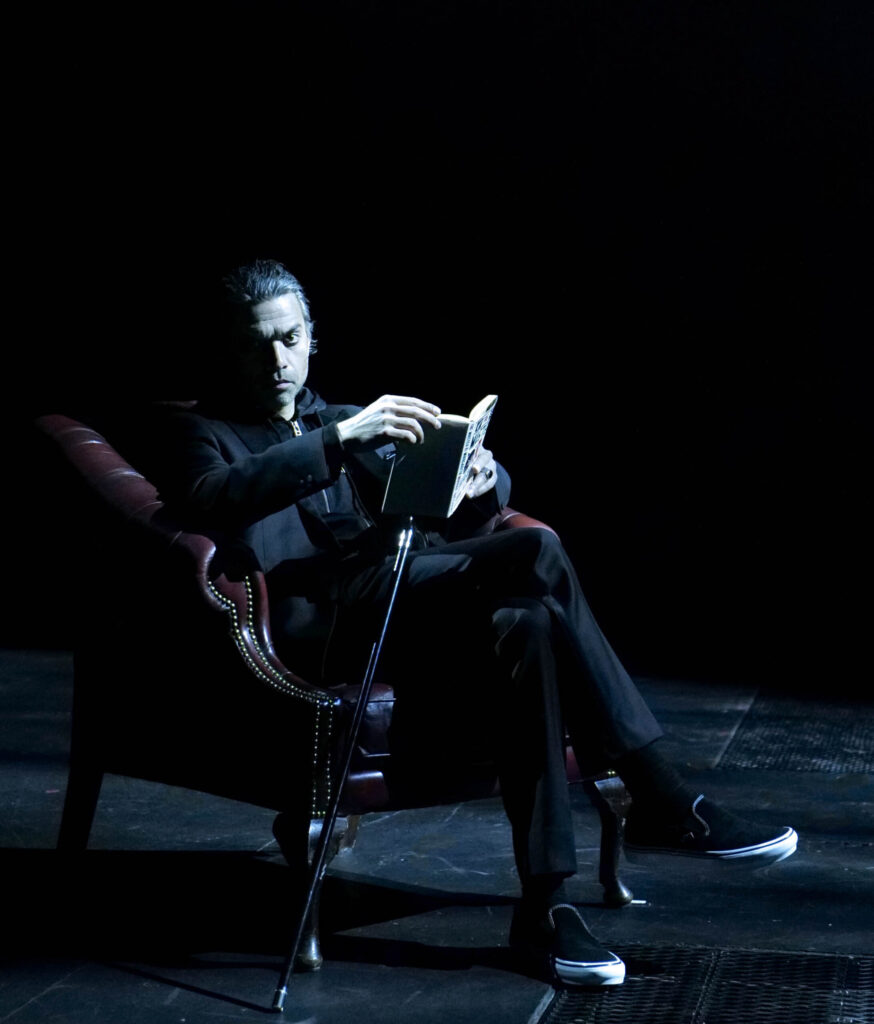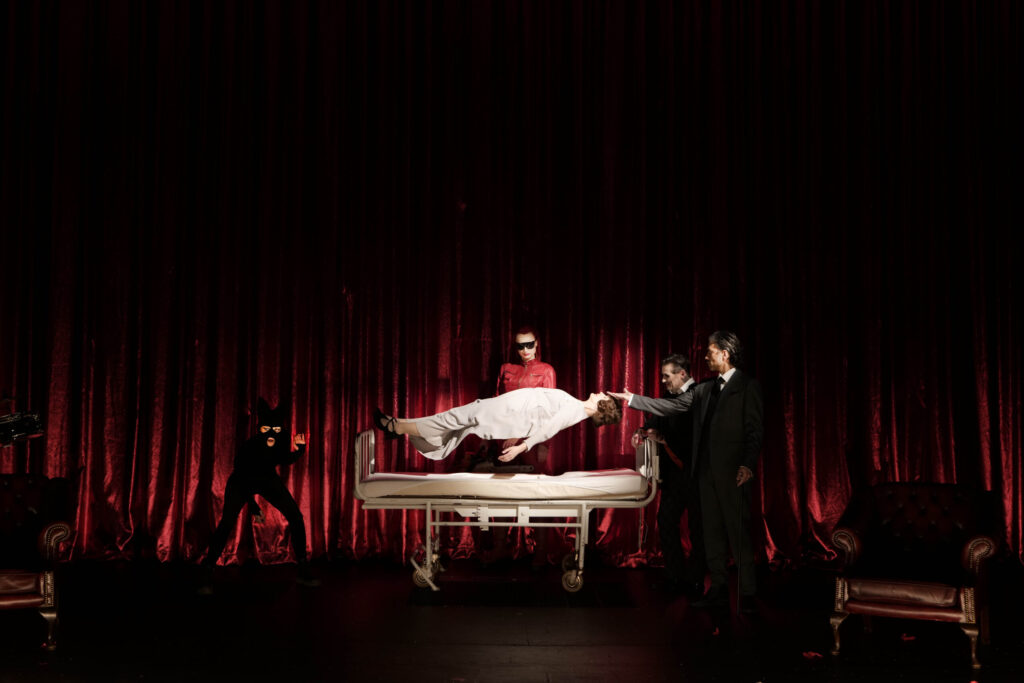The devil has landed in Bergen
Rakeb Erana (22 years old)
The production of The Master and Margarita manages to draw clear parallels between Moscow in the 1930s and Bergen today. The play shows what the people of these two cities have in common, both good and bad.
Den Nationale Scene in collaboration with Bergen International Festival brings director Simon K. Boberg to this dramatization of The Master and Margarita. Boberg confidently demonstrates that he knows the novel inside out, and has a strong ensemble to realize his vision.
The Master and Margarita is set in the 1930s in Moscow, the political and cultural center of the Soviet Union. On a seemingly ordinary spring day, Moscow is unexpectedly visited by the devil and his faithful companions. This turns the city upside down from the start, as the devil meets with an editor and a poet at the Patriarch Ladies. At the same time as he and his companions are wreaking havoc in Moscow, Margarita longs for her lover, the master, who has disappeared. As the story unfolds in Moscow in the 1930s, we are taken back to the year 33 and witness Jesus' last days with Pilate.
A Woland theater history will not forget
Datarock vocalist Fredrik Saroea leads the performance as the devil; Woland. It's hard to imagine anyone other than Saroea as Woland - he has the charm, elegance, wit and comedy Woland is known for. Costume designer Silje Benedict Pedersen hits the bull's eye with the styling of Saroea for the role, so that he looks exactly like the description of Woland in the book. Together with Saroea, this is a Woland theater history will not forget.

The rest of the cast shine just as strongly. Eirik del Barco Soleglad presents the demon Koroviev with charm, audacity and humor. In Jerusalem, where Knut Erik Engemoen plays Jesus and Svein Harry Schöttker-Hauge plays Pilate, the ideological tension between them is clear. Despite the fact that there are only twelve actors in the cast, the scene feels full and alive.
Demanding work to adapt to theater
Although The Master and Margarita is a demanding work to adapt to the theater, set, costume and lighting designer Edward Lloyd Pierce succeeds in transforming the atmosphere of the stage and the auditorium into an impressive recreation of that found in the novel. Magic and the mystical are central elements in The Master and Margarita, and the production is keen to preserve this essence. Together with consulting magician Roy Bjerke, the production has succeeded in bringing the magic of The Master and Margarita into the world of smoke. The production ensemble has created a great play where everything from stage design, sound design, costumes and choreography, to magic and lighting technology flows well together and creates an unforgettable retelling of The Master and Margarita.
Different timelines
The production also has its own identity, even though it is an adaptation. Many of the supernatural and magical elements have been modernized, and include original sets, props, costumes and lines to bring it closer to our time. This is probably the most striking aspect of the production - you are taken on a journey that stretches from the year 33 to 1930s Moscow, and finally, to contemporary Bergen.

Magic opens up a range of creative possibilities when it comes to the Master and Margarita. The production takes full advantage of this, using it as a tool to include the audience in the mystery of the play - consistently leading to the production breaking the fourth wall. Parallel to the first two timelines in The Master and Margarita, contemporary Bergen is the third timeline. While the devil and his companions use humor and satire to criticize Moscow and the city's inhabitants in the 1930s, they also turn to the audience and criticize the people of Bergen for their double standards. You can experience cognitive disharmony when you hear laughter from people in Bergen who laugh and make light of the criticism directed at them. This reinforces the elements of satire in the performance, and serves as a reminder to be aware of one's own double standards.
The National Stage has staged a spectacular retelling of The Master and Margarita. Boberg didn't just want to create a retelling, he wanted to breathe new life into the novel - and he succeeds. You can really feel that every person involved in the production has a deep love for the novel, and wants to create an adaptation that honors his legacy.
All photos: Sebastian Dalseide / Bergen International Festival
This message is a collaboration between Unge Stemmer, Tidsskriftet Jaja and Framtida.no.
The Master and Margarita
The National Stage / Bergen International Festival
Friday, May 24th
Azazello: Kjetil Møster
Woland: Fredrik Saroea
The Master: Herman Bernhoft
Margarita: Irene Waage
Koroviev: Eirik del Barco Soleglad
Ivan/Levi: Kristina Berg Jåtten
Pilate/Stravinsky and others: Svein Harry Schötter-Hauge
Jesus/Stjopa et al: Knut Erik Engemoen
Berlio/Rimsky et al: Tormod Løvold
Annushka, Varenucha et al: Katrine Dale
Behemoth and others: Kristi-Helene J. Engeberg
Hella et al: Ida Klem
Azazello (substitute): Aksel Røed
Director: Simon K. Boberg
Set, costume and lighting designer: Edward Lloyd Pierce
Composer: Fredrik Saroea
Musicians: Stian Balducci, Kjetil Møster
Choreographer: Piero Issa
Consulting magician: Roy Bjerke
Dramaturg: Kjersti Gulliksrud, Lillian Bikset
Language editing: Demian Vitanza
Assistant director: Margaryta Grynko
Director: Kristine Nordby Simonsen / Sandra Olea Jakobsen
Lighting designer: Ida Charlotte Brønn / Kari-Ann Skårbø
Lighting technician: Anne Elisabeth Bergendahl / Dag Tømmerbakke
Sound technician: Bjarte Våge / Rune Bjorøy
Technical stage manager: Even Kråkenes
Prop maker: Espen Røen / Cathrine Hopstock
Mask maker: Silje Benedicte Lie / Frida Rykkje
SFX head: Mette Noodt
Costume manager: Silje Teland Pedersen
Costume assistant and prop maker: Simen Mustvedt
Costume technician: Julie Jensen / Anja Marie Homestad Thorsen
Suffluor: Birte Valkyrje Rolland /Britney Elise Sudmann-Mack
All photos: Sebastian Dalseide / Bergen International Festival
Rakeb Erana
Rakeb Erana is 22 years old and studies physics at the University of Bergen. In her spare time, she is involved in art, culture and politics. Rakeb participated in the Critics' Seminar in Fjaler for new voices on art and culture organized by the magazine Jaja and the Jakob Sande Center for Narrative Art in the spring of 2024.